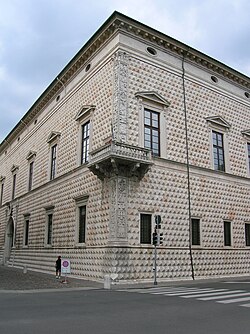|
Palazzo dei Diamanti
Palazzo dei Diamanti is a Renaissance palace located on Corso Ercole I d'Este 21 in Ferrara, region of Emilia Romagna, Italy. The main floor of the Palace houses the Pinacoteca Nazionale di Ferrara (National Painting Gallery of Ferrara). HistoryTo accommodate the growth of Ferrara, in 1492 the Duke Ercole I d'Este demolished the medieval walls of the city on the north, and had the court architect, Biagio Rossetti, design an urban expansion known as the Addizione Erculea. Rosetti was commissioned by Sigismondo d'Este, brother of the Duke Ercole I, to build this palace at the prestigious intersection of what was to be the Decumanus Maximus (now encompassing Corsi Porta Po, Biagio Rossetti, and Porta Mare) and Cardo Maximus (Corso Ercole I d'Este) of the "urban addition". It was built between 1493 and 1503. Used as a residential home by the Este family and, starting in 1641, by the Villa marquis, in 1832 the palace was acquired by the municipality of Ferrara to house the National Gallery of Art and the Civic University. Architecture The most striking feature is the bugnato of the exterior walls: it consists of some 8,500 white (with pink veins) marble blocks carved to represent diamonds, hence its name. The positioning of the diamonds varies in order to maximize the light reflected off the building, creating quite the visual effect. The palace is also well known for its candelabra and the phytomorphic corner motifs. Inside, it has a typical Renaissance courtyard with a cloister and a marble well; the latter is a characteristic typical of gardens in Ferrara. Pinacoteca Nazionale di Ferrara The main floor of the palazzo houses the Pinacoteca Nazionale (transl. national picture gallery), with paintings from the Ferrarese School from the Middle Ages up to the 18th century. The oldest paintings are large frescoes (Triumph of sant'Agostino by Serafino da Modena) and wooden panels with gold-leaf backgrounds, such as the Madonna and Child by Gentile da Fabriano. The main artists from the 15th century in Ferrara represented in the museum are Cosmè Tura (Giudizio and Martyrdom of san Maurelio), Ercole de' Roberti, Vicino da Ferrara and Michele Pannonio. There are works from the Este family collections, including a work by Andrea Mantegna (Cristo con l'animula della Madonna). There are also two works by unidentified artists from the collection of the Marquis Leonello d'Este at the Belfiore Palace. The major 16th-century Ferrarese painter, Garofalo, is represented by a number of works, including Pala Costabili, done in collaboration with Dosso Dossi. The period of mannerism is represented by Bastianino, who uses a technique similar to that of Michelangelo in his works. Among the other artists in the collection are Amerigo Aspertini, Giuseppe Avanzi, Baldassarre d'Este, Jacopo Bambini, Bastarolo (Giuseppe Mazzuoli), Giovanni Bellini, Jacopo Bellini, il Ortolano, Carlo Bononi (1569–1632), Vittore Carpaccio, Girolamo da Carpi (1500–1556), Agostino Carracci, Ludovico Carracci, Coltellini (1480–1535/42), Francesco del Cossa (1435/1436–1478), Lorenzo Costa (c. 1460–1535), Giulio Cromer, Girolamo Domenichini, Battista Dossi (c. 1490–1548), Francesco Francia (1450–1517), Gaetano Gandolfi, Ubaldo Gandolfi, Maestro degli Occhi Spalancati, Maineri, Giovanni da Modena (active 1398), Ludovico Mazzolino (c. 1480), Panetti, Giacomo Parolini, Nicolò Pisano (Nicolò dell'Abrugia), Nicolò Roselli (1500–c. 1580), Maurelio Scannavini, Scarsellino (c. 1550–1620), Simone de Crocifissi, Tintoretto, Bartolomeo Vivarini, and Giuseppe Zola (1672–1743).[1] Civic Gallery of Modern and Contemporary ArtOn the lower floor, there is the Civic Gallery of Modern and Contemporary Art, which has hosted high level temporary shows since 1992, when the space was inaugurated by the show on Claude Monet and his friends. Some of the most important shows held here have included:
See alsoReferences
External links
|
||||||||||


